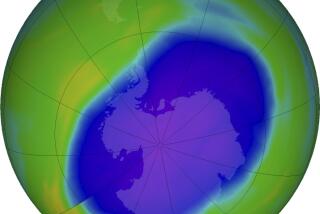NASA Details Findings on Chlorine, Ozone Hole : Science: Satellite tests conclude that man-made CFCs are the culprit in atmospheric loss. Results refute theories that natural sources are more to blame.
- Share via
WASHINGTON — Three years of satellite data have provided conclusive evidence that man-made chlorine in the stratosphere--not natural phenomena--is the primary cause of the ozone hole above Antarctica, federal scientists said Monday.
“The detection of stratospheric fluorine gases, which are not natural, eliminates the possibility that chlorine from volcanic eruptions or some other natural source is responsible for the ozone hole,” National Aeronautics and Space Administration scientist Mark Schoeberl said at a news briefing.
Scientists have warned for years that the widespread use of chlorofluorocarbons (CFCs) in refrigerators, spray cans and foam packaging was responsible for stratospheric ozone loss. But some critics have claimed that such natural factors as volcanic eruptions and sea spray have been a far larger cause.
Now, however, NASA can end the debate because “these new results confirm our theories about CFCs,” Schoeberl said.
NASA’s announcement represented the first ozone data to be revealed from its upper-atmosphere research satellite launched Sept. 15, 1991, from the space shuttle Discovery. The satellite has 10 instruments measuring stratospheric temperatures, winds and trace gases that affect ozone.
Schoeberl and Anne Douglass of the Goddard Space Flight Center explained that ozone is a molecule of oxygen containing three oxygen atoms instead of the usual two. Although poisonous, its presence in the upper atmosphere is regarded as vital to the survival of many forms of life. By blocking ultraviolet radiation produced by the sun, ozone protects humans from damage to the immune system and from the increased risk of cataracts and skin cancer.
Jay R. Herman, another research scientist at Goddard, has reported that the hole is smaller this year but that the overall ozone loss in the Antarctic is “much the same as last year.” Schoeberl and Douglass had no new data on the size of the hole, which is said to be as large as North America.
A gloomier assessment recently was reported by Jonathan Shanklin of the British Antarctic Survey, who calculated that, at the present rate of destruction, the ozone above Antarctica could be fully depleted by the year 2005.
Although CFCs are being phased out under international agreements, scientists fear that it will take decades before there is substantial improvement in the ozone layer. The banned products, though no longer manufactured, will still be in use for years in existing refrigerators, air conditioners and cooling systems, scientists noted.
Because of the severity of its ozone hole, Antarctica has been considered the best laboratory to study the Earth’s shrinking ozone layer. But that laboratory now includes North America, where “the last two years are the worst two on record,” according to James Anderson, a Harvard University atmospheric chemist.
Schoeberl and Douglass said that the satellite data is part of an ongoing NASA project called Mission to Planet Earth, a comprehensive study of how the Earth’s global environment changes and how human activities contribute to that change. Results are distributed to researchers worldwide.
Eye on Environment
* A collection of recent Times stories on the environment, covering everything from ozone to the ivory trade, is available on the TimesLink on-line service in the Nation & World section.
Details on Times electronic services, B4






